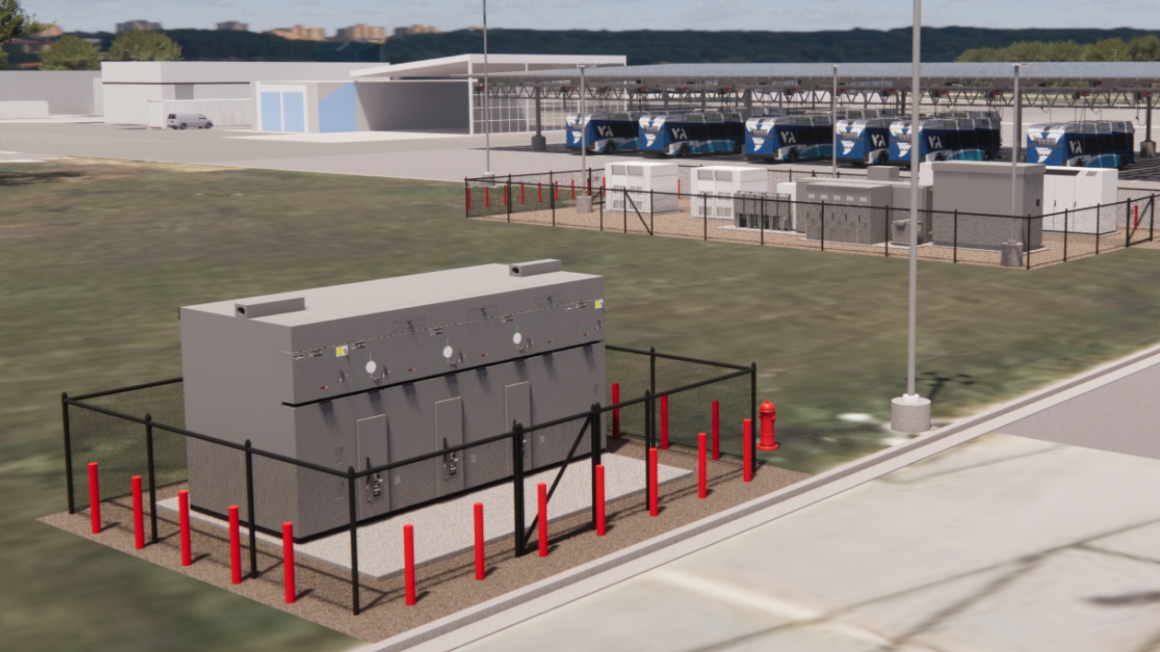An innovative project to charge dozens of electric transit buses broke ground at the Santa Clara Valley Transportation Authority’s (VTA) Cerone Bus Division. The Cerone Microgrid Project pairs bus charging infrastructure with solar panels and a microgrid which stores electricity onsite in large batteries and can keep buses charged in the event of a major blackout. Experts in green energy, microgrids, and transit operations were on hand at the construction site Friday, September 26 to discuss the new technology.
The press event was streamed on Facebook Live.
The inclusion of a Microgrid and solar panels makes the project unique among such endeavors as it will allow VTA to collect its own renewable energy to pair with grid electricity to power its zero-emission bus operations. The microgrid is being built for VTA by Scale Microgrids to give VTA a sustainable and reliable platform to power a growing fleet of electric buses. Thirty-five battery electric buses are expected to be delivered to VTA in 2026, which takes VTA a step closer to meeting the state goal for all California transit agencies to operate only zero-emission fleets by 2040.
"We're proud to partner with VTA to showcase how microgrids can support their ambitious transit fleet electrification goals," said Neil Maguire, Scale's Chief Technology Officer. "By integrating on-site solar and battery storage, our microgrid will help VTA serve the region's public transit needs while reducing their electricity costs by over a third, cutting carbon emissions by more than 60%, and - most importantly - ensuring reliable operations to continue to serve the community even during power outages on the grid."
VTA’s Board Chair and Campbell Mayor Sergio Lopez lauded the agency’s commitment to helping to protect the environment in Santa Clara County.
“Expanding our zero-emission bus fleet reflects my priority to modernize VTA’s operations while improving air quality and reliability for the communities we serve,” said Lopez. “It also advances our commitment to equity. These new buses will serve Eastern and Central San Jose—areas with high transit use and historically high pollution,” Lopez said.
Automated smart charging will occur overnight, allowing VTA to minimize electrical costs and have the buses ready for service each morning. To meet VTA’s increased need for electricity, PG&E is upgrading the electrical capacity of the Cerone Division by 3 megawatts.
“PG&E is proud to power VTA’s transition to a zero-emission fleet. This is the kind of collaboration that moves clean energy forward,” said Jeremy Howard, Senior Regional Manager at PG&E. “By supporting EV charging infrastructure, we’re helping VTA build flexibility and resiliency into their operations.”
San Jose Clean Energy also supports this endeavor’s goal of reducing harmful vehicle emissions.
“With on-site solar, batteries, and smart charging, the VTA microgrid will keep essential bus service running—even when the grid is stressed,” said Zachary Struyk, Assistant Director, San José Clean Energy. “Paired with electricity supply from San José Clean Energy that is more than 90% carbon-free, we can reduce climate pollution and help protect our community from the impacts of climate-driven challenges.”
Lehigh University’s Institute of Cyber Physical Infrastructure is a leading research entity in the smart grid space, partnering with VTA to support the research and planning of the electric fleet rollout.
"Our researchers and students have been working alongside VTA to develop ways to use local energy storage and solar generation, schedule bus charging, implement routes, assign bus operators, and coordinate with the main grid," said Shalinee Kishore, Iacocca Chair and professor of electrical and computer engineering, and director of Lehigh's Center for Advancing Community Electrification Solutions (ACES).
Altogether, VTA is projected to save about $1.2 million a year on energy costs, which is a savings that can be put toward other operating needs, like transit service.

